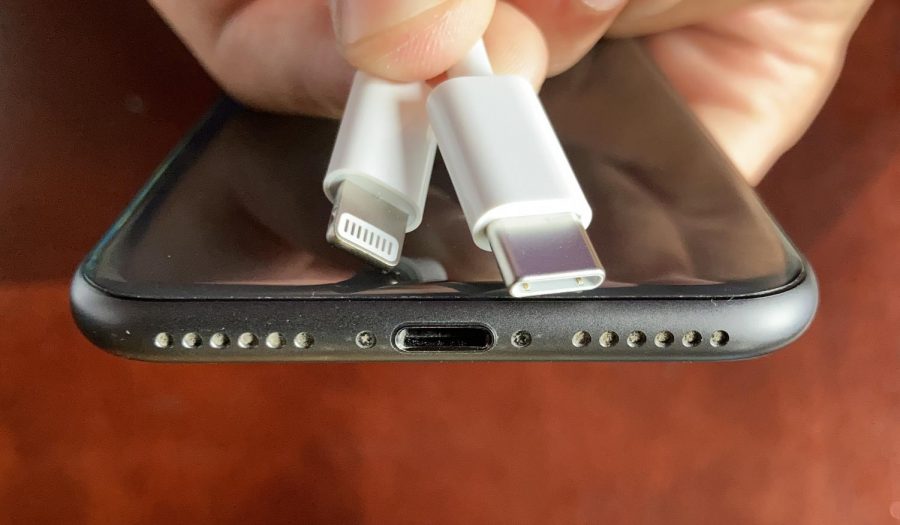The European Commission (EC) released plans on Sept. 23 to mandate all cameras, headphones, tablets, portable speakers and video game consoles to have a common USB-C port for charging. Although this decision is oriented for countries in another continent, it has the potential to affect people all over the world.
This new rule was proposed with the hope of creating a universal cable that could eliminate having multiple chargers every time a new phone is bought. A potential universal charger would also tackle the electronic waste (e-waste) produced by unused chargers by encouraging European consumers to re-use their existing cables when buying a new device.
Eleven thousand metric tonnes of disposed and unused charging cables are estimated to be generated per year according to the EU. The goal is that by standardizing the cables the devices use, e-waste will be reduced by almost 1,000 tonnes annually, substantially helping reduce Europe’s environmental footprint.
As a by-product of using fewer cables to charge more devices, the EU also aims to increase the convenience of only using one cable to satisfy all the consumers’ charging needs. Consumers would be able to travel anywhere with only one cable to charge all their devices.
Although this plan was proposed for Europe, companies all over the world would have to comply with this mandate if they wish to sell their products there.
Many companies, such as Samsung, Motorola, LG and Google, are already using USB-C in many of their smartphones and remain largely unaffected by this mandate; however, Apple, which has used its proprietary Lightning connector in its smartphones since 2012, is not pleased to hear about this new proposal.
A spokesperson for Apple stressed that a standardized cable for all smartphones will restrain novelty. “We remain concerned that strict regulation mandating just one type of connector stifles innovation rather than encouraging it, which in turn will harm consumers in Europe and around the world,” Apple stated.
Money also plays a role in Apple’s reluctance to switch to USB-C. In order for third-party accessories to work with Apple’s products that use a Lightning connector, Apple licenses out the connector as part of the Made for iPad, iPhone, iPod (MFI) program. The companies that want to use Lightning connector in their own products have to pay a fee. Apple would lose out on this fee if they were to switch to USB-C in their devices.
Apple would also risk damaging the lightning “ecosystem” many people already have cables for. All the cables that use Apple’s proprietary connector would immediately be obsolete. Lightning only works with Apple products, so by switching to USB-C, consumers are not limited to buying Apple products since it would be as convenient to buy a product with USB-C. For example, a consumer could buy different wireless earbuds that use USB-C instead of the Airpod Pros that use Lightning.
In regards to PV, students and staff are divided on the decision to implement USB-C into iPhones. In a recent poll on the Spartan Shield Instagram asking if they would switch to an iPhone with a USB-C port, 55% of the PV population indicated they would switch while 45% would not switch.
Senior Arsh Manazir is enthusiastic about only having to carry one cable with him. “Generalizing cables would be a great benefit for me because it would mean not needing multiple cables, ” he explained. “For example, my Macbook uses USB-C, and my iPhone does not. If they were both USB-C, I wouldn’t have to worry about needing two cables wherever I go.”
On the other hand, many are uncertain that this mandate would be the best for everyone.
Science teacher and avid Apple Fan Craig Parker sides with those who are hesitant about switching, conveying that the proposal itself is not a good idea. “I am opposed to the mandate because companies should be free to create products they think consumers want, and consumers—not politicians—should be free to choose the best product for themselves,” Parker expressed. “Charging/data transfer cords have been getting better over time, a mandate might stifle this evolution.”
In order for this USB-C standardization to be in effect, the proposal will need to pass a vote in the European Parliament before it becomes law. Manufacturers will then have a two year period to make changes to their products. The EC aims for this to happen as early as 2022.
The standardized phone charger port mandate, aiming to make life more convenient for European consumers, would have a ripple effect all around the world should this proposal become law. Those arguing for or against this potential law can agree that consumers’ interactions with their products will dramatically change. Should that change be for the better or for the worse is up for the consumers to decide.









Devin • Oct 20, 2021 at 10:06 pm
I think this change could be huge for the waste problem we already have. But how would the producers of the electronics feel about having a universal cord for every appliance instead of making customers buy their specific cord that correlated to their product.
Gavin Pangan • Oct 15, 2021 at 11:30 am
It is interesting to see how this mandate will have ripple effects all around the world that you wouldn’t expect. As an iPhone user, I only use the Lightning charger and wouldn’t care much for a change in cables, but I also recognize that a charger mandate discourages innovation.
Makayla Clark • Oct 13, 2021 at 11:09 am
I have been extremely curious of what Apple has been doing with the Iphones. I currently have an Iphone 7 and my mom has the 12. When she got the 12 she asked to use my charger, I gave it to her and it didn’t work. They had changed the changer, which sucked for her considering she just bought a new charger. I personally think it’s a good idea to have a cord that will work on all devices. This article is extremely well written and informative.